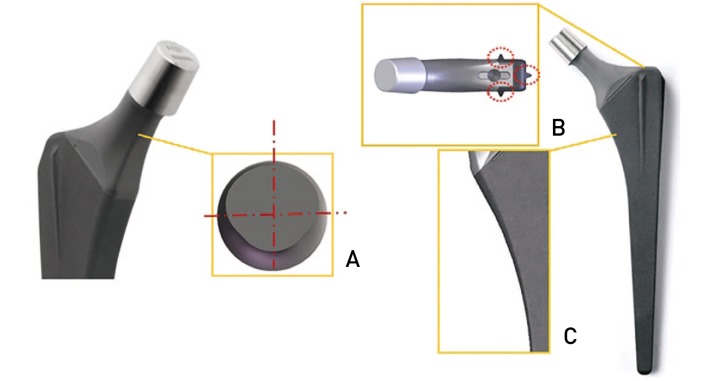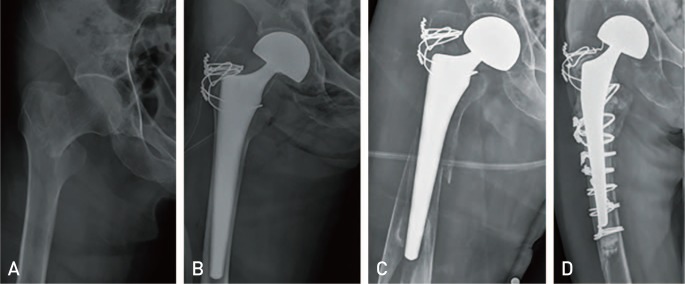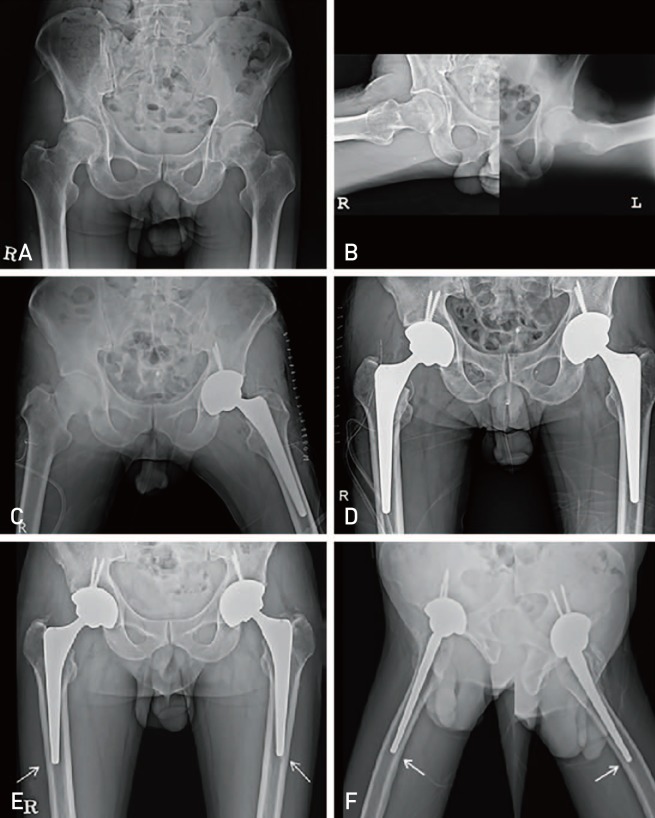1. Learmonth ID, Young C, Rorabeck C. The operation of the century: total hip replacement. Lancet. 2007; 370:1508–1519. PMID:
17964352.

2. Banaszkiewicz PA. Radiological demarcation of cemented sockets in total hip replacement. In : Banaszkiewicz PA, Kader D, editors. Classic Papers in Orthopaedics. London: Springer;2014. p. 39–41.
3. Rothman RH, Cohn JC. Cemented versus cementless total hip arthroplasty. A critical review. Clin Orthop Relat Res. 1990; (254):153–169.
4. Malik A, Maheshwari A, Dorr LD. Impingement with total hip replacement. J Bone Joint Surg Am. 2007; 89:1832–1842. PMID:
17671025.

5. Kim S, Lee JM, Kim WH, Han JK, Lee JY, Choi BI. Focal peliosis hepatis as a mimicker of hepatic tumors: radiological-pathological correlation. J Comput Assist Tomogr. 2007; 31:79–85. PMID:
17259837.
6. Kim JT, Yoo JJ. Implant design in cementless hip arthroplasty. Hip Pelvis. 2016; 28:65–75. PMID:
27536647.

7. Lim Y, Chang YJ, Kwon SY, Kim YS. A simple method using a PACS to minimize leg length discrepancy in primary THA: a method to minimize leg length discrepancy. J Arthroplasty. 2013; 28:1791–1795. PMID:
23540533.
8. Bourne RB, Rorabeck CH. Soft tissue balancing: the hip. J Arthroplasty. 2002; 17(4 Suppl 1):17–22. PMID:
12068397.

9. Masonis JL, Bourne RB. Surgical approach, abductor function, and total hip arthroplasty dislocation. Clin Orthop Relat Res. 2002; (405):46–53. PMID:
12461355.

10. Lee JM, Cho Y, Kim J, Kim DW. Wiring techniques for the fixation of trochanteric fragments during bipolar hemiarthroplasty for femoral intertrochanteric fracture: Clinical study and technical note. Hip Pelvis. 2017; 29:44–53. PMID:
28316962.

11. Banaszkiewicz PA. Ectopic ossification following total hip replacement: incidence and a method of classification. In : Banaszkiewicz PA, Kader D, editors. Classic Papers in Orthopaedics. London: Springer;2014. p. 105–107.
12. Chan KC, Gill GS. Cemented hemiarthroplasties for elderly patients with intertrochanteric fractures. Clin Orthop Relat Res. 2000; (371):206–215.

13. von Roth P, Abdel MP, Harmsen WS, Berry DJ. Cemented bipolar hemiarthroplasty provides definitive treatment for femoral neck fractures at 20 years and beyond. Clin Orthop Relat Res. 2015; 473:3595–3599. PMID:
26186915.

14. Hong CC, Nashi N, Makandura MC, Krishna L. Cemented hemiarthroplasty in traumatic displaced femoral neck fractures and deep vein thrombosis: is there really a link? Singapore Med J. 2016; 57:69–72. PMID:
26892829.

15. Stauffer RN. Ten-year follow-up study of total hip replacement. J Bone Joint Surg Am. 1982; 64:983–990. PMID:
7118986.

16. Sutherland CJ, Wilde AH, Borden LS, Marks KE. A ten-year follow-up of one hundred consecutive Müller curved-stem total hip-replacement arthroplasties. J Bone Joint Surg Am. 1982; 64:970–982. PMID:
7118985.

17. Bourne RB, Rorabeck CH, Ghazal ME, Lee MH. Pain in the thigh following total hip replacement with a porous-coated anatomic prosthesis for osteoarthrosis. A five-year follow-up study. J Bone Joint Surg Am. 1994; 76:1464–1470. PMID:
7929493.

18. Lavernia C, D'Apuzzo M, Hernandez V, Lee D. Thigh pain in primary total hip arthroplasty: the effects of elastic moduli. J Arthroplasty. 2004; 19(7 Suppl 2):10–16. PMID:
15457412.
19. Lee JM, Jeon JB. Result of a minimum five-year follow-up of hip arthroplasty using the Bencox® hip stem. J Korean Orthop Assoc. 2014; 49:126–132.

20. Cruz-Pardos A, García-Rey E, García-Cimbrelo E. Total hip arthroplasty with use of the cementless Zweymüller Alloclassic System: A concise follow-up, at a minimum of 25 years, of a previous report. J Bone Joint Surg Am. 2017; 99:1927–1931. PMID:
29135666.
21. Lee JM, Park YS. Long-term follow-up results after hip arthroplasty using a Cementless Spotorno (CLS) femoral stem. J Korean Orthop Assoc. 2008; 43:710–717.

22. Müller LA, Wenger N, Schramm M, Hohmann D, Forst R, Carl HD. Seventeen-year survival of the cementless CLS Spotorno stem. Arch Orthop Trauma Surg. 2010; 130:269–275. PMID:
19760225.

23. Haentjens P, Casteleyn PP, De Boeck H, Handelberg F, Opdecam P. Treatment of unstable intertrochanteric and subtrochanteric fractures in elderly patients. Primary bipolar arthroplasty compared with internal fixation. J Bone Joint Surg Am. 1989; 71:1214–1225. PMID:
2777850.

24. Barrack RL, Butler RA. Current status of trochanteric reattachment in complex total hip arthroplasty. Clin Orthop Relat Res. 2005; 441:237–242. PMID:
16331009.

25. Koyama K, Higuchi F, Kubo M, Okawa T, Inoue A. Reattachment of the greater trochanter using the Dall-Miles cable grip system in revision hip arthroplasty. J Orthop Sci. 2001; 6:22–27. PMID:
11289581.

26. Lim SJ, Lee KJ, Min BW, Song JH, So SY, Park YS. High incidence of stem loosening in association with periprosthetic femur fractures in previously well-fixed cementless grit-blasted tapered-wedge stems. Int Orthop. 2015; 39:1689–1693. PMID:
25385003.








 PDF
PDF ePub
ePub Citation
Citation Print
Print







 XML Download
XML Download